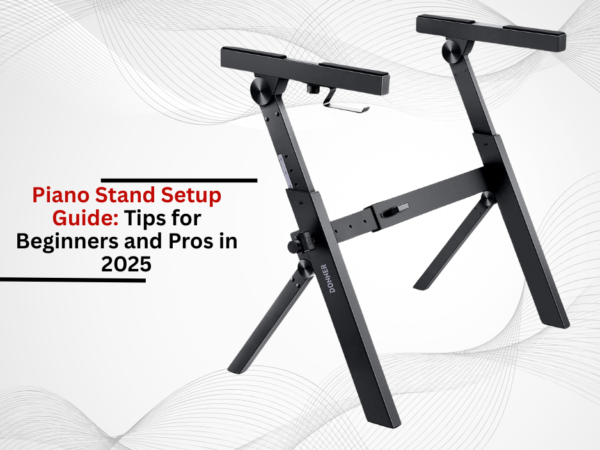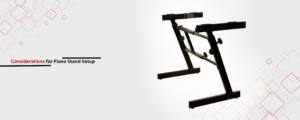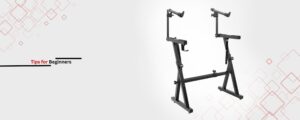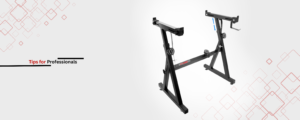A piano stand is commonly regarded as an afterthought equated with an accessory. Furthermore, its importance in maintaining ergonomic stance, acoustic alignment, and beauty balance is often neglected. With hybrid models, smart integrations, and compact designs dominating the market in 2025, there is careful consideration that needs to be taken when choosing and configuring the right stand. This guide ensures that beginners and advanced users of the piano are equipped with essential strategies to provide functionality and meet modern demands in terms of music.
To know more, read: The Evolution of Keyboard Stands: From 1980s X-Frames to 2025 Smart Stands
Key Considerations for Piano Stand Setup
The perfect setup will always integrate flexibility, ease of use, and coordination with the pianist’s unique profile.
Relevant Ergonomics and Landscapes:
Flexible height and angle range offers relief during long practice hours. The keyboard or piano should sit at elbow height while sitting for maximum comfort, which is 28–30 inches for adults. Adjustable stands with tilting ranges allow different vertical postures for grasping, which accommodates streamlined playing styles, from classical to contemporary.
Weight Limit Stability:
Stands must support the instrument’s weight without wobbling and maintain stability on uneven surfaces. Digital pianos need a minimum weight capacity of 30–50 lbs, while reinforced steel or hardwood is required for acoustic piano stands.
Space Optimization:
The sleek and compact designs are optimal for smaller studios, while multi-tier stands are more suited for synthesizers or layered configurations. As of 2025, there is a surge in wall-mounted designs due to minimalistic aesthetics.
Acoustic Performance:
For acoustic pianos, sound clarity is enhanced with anti-vibration padding or open-back designs. Digital models incorporate stands with cable management systems to further reduce clutter.
Setup Tips for Beginners
Fixing the height to a set level is ideal and the same goes for novice pianists who enjoy uncomplicated frameworks that endure wear and tear.
Adjustable Height Takes Priority:
Stands like Z-style or tabletop are advantageous because they can be easily modified in height. Automatic knobs or levers that do not require tools are preferred.
Lightweight Portability:
Foldable stands like X-frames are collapsible, allowing for convenient storage and transportation. This is most useful for learners and those living in cramped quarters.
Basic cable management ensures:
Power and MIDI cables that are attached to the stand are secured using clips or channels, making them less of a tripping hazard.
Advanced Setup Tips for Professionals
Customization, precise settings, and flexibility for modern equipment are some of the needs advanced users have.
Layered setups with multi-tier stands:
Using 2-3 tiered stands is something professionals take advantage of since it provides space for extra keyboards, tablets, or even controllers. Crossbars need added reinforcement to support the additional weight.
Acoustic Resonance Optimization:
To ensure optimal use of equipment, hardwood stands with anti-slip pads are used on grand and upright pianos. The hardwood also improves the stability and tonal projection of the instrument, while anti-slip pads minimize vibrations and floor damage.
Integration of new technology:
By 2025, incorporating USB ports, wireless charging stations, and tablet holders into stands will simplify workflow. Bluetooth technology will enable stand syncing with apps for direct link page turning, allowing for instant sheet music display.
Predicted Advances in Piano Stand Design (2025)
Implementation of modern technologies and material science is expected to standardize features.
Sustainable Materials:
Materials such as aluminum, bamboo, and biodegradable composites are environmentally friendly substitutes for steel, recycled plastic, and traditional materials used in making piano stands.
Modular and customizable designs:
Versatile stands are set to allow users to change accessories like tiers for different performances or genres by allowing magnetic, removable and interchangeable attachments.
AI-Assisted Ergonomics:
AI posture sensors are now being introduced in piano stands to provide real-time height adjustments and other recommendations that prevent injuries.
Conclusion
The choice of piano stands in 2025 is dictated by K&M, 5 Core, Roland and Donner. These brands attend to differing pianist preferences/requirements in terms of stability, portability and innovation. While different in focus, all these manufacturers strive to ensure their products in unison enable setups to meet modern standards. These brands lead the development of new and innovative solutions for monitoring traditional performances. As musical technology evolves, these brands continue to enhance, refine and redefine solutions in anticipation of traditional and new performance needs.




